January 15, 2021
Air Date: January 15, 2021
FULL SHOW
SEGMENTS
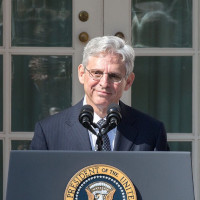
Merrick Garland and the Environment
View the page for this story
President-elect Biden announced his choice for Attorney General, naming Judge Merrick Garland, who has served on the U.S. Court of Appeals in DC for over 20 years. In his position as chief judge, he's ruled over many disputes relating to environmental rules and regulations. Vermont Law School Professor Pat Parenteau joins Host Steve Curwood to offer some perspective on what an AG Garland could mean for environmental policy and enforcement. (11:25)
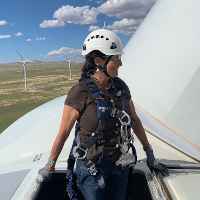
Deb Haaland: ‘Fierce for our Planet’
/ Jenni DoeringView the page for this story
Congresswoman Deb Haaland of New Mexico is President-elect Biden’s nominee for Secretary of the Interior. She’ll be the first Native American to lead the Department if confirmed, and would bring a strong conservation, climate action, and tribal rights perspective to the department. Living on Earth’s Jenni Doering reports on Deb Haaland’s experience and what’s shaped her into who she is today. (06:34)
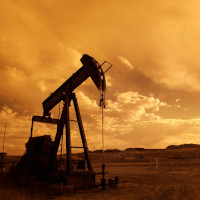
Interior’s Next Frontiers
View the page for this story
After four years in pursuit of extraction at the expense of conservation, the Department of the Interior is about to undergo a major change in how it manages federal public lands and relates to Native Americans. Sally Jewell, former U.S. Secretary of the Interior under President Obama, joins Host Bobby Bascomb to discuss how the Biden administration can halt the advance of oil and gas extraction on public lands, attract more renewable energy and restore the sacred Bears Ears National Monument. (12:40)
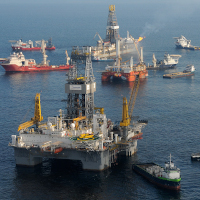
Beyond the Headlines
/ Peter DykstraView the page for this story
This week Environmental Health News Weekend Editor Peter Dykstra and Host Steve Curwood remark on 2020’s tie with 2016 for the hottest year on record, and explore the climate-warming consequences of methane leaks from abandoned oil and gas wells in the ocean. They then turn to the history calendar to celebrate the birthday of Aldo Leopold, the renowned author of Sand County Almanac and the ecologist known as “the father of wildlife conservation”. (04:32)
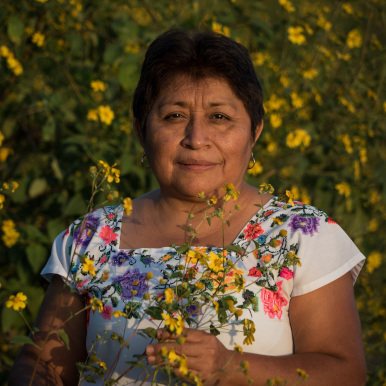
A Mayan Bee Guardian
View the page for this story
A Mayan beekeeper who organized a grassroots campaign to stop the use of genetically modified soybeans and glyphosate on her people’s territory is the 2020 Goldman Environmental Prize recipient for Central and South America. Leydy Pech joined Host Bobby Bascomb to talk about the legal battle to protect the environment and the indigenous Mayan community’s ancient practice of beekeeping. (07:08)
Ice Visions
/ Erik HoffnerView the page for this story
As winter settles in over the northern hemisphere people find creative ways to get outside and enjoy nature. For environmental journalist and photographer Erik Hoffner, winter is a time for ice skating, a passion which gave rise to some unusual art, now 20 years in the making. (03:33)
Show Credits and Funders
Show Transcript
210115 Transcript
HOSTS: Bobby Bascomb, Steve Curwood
GUESTS: Sally Jewell, Pat Parenteau, Leydy Pech
REPORTERS: Jenni Doering, Peter Dykstra, Erik Hoffner
[THEME]
CURWOOD: From PRX – this is Living On Earth.
[THEME]
CURWOOD: I’m Steve Curwood.
BASCOMB: And I’m Bobby Bascomb.
Judge Merrick Garland is the nominee for Attorney General, and some like how he might act as the government’s lawyer in environmental cases.
PARENTEAU: He's got a strong record on the environment, he's got a deep respect for science. When you read a Garland opinion, you can see right away that he digs into what's the problem in the case. If you do your homework and you've prepared based on science, he will uphold the Agency.
CURWOOD: Also, Deb Haaland of the Laguna Pueblo tribe is Joe Biden’s pick to run the Interior Department.
HAALAND: Growing up in my mother’s Pueblo household made me fierce. I’ll be fierce for all of us, for our planet and all of our protected land, and I’m honored and ready to serve.
CURWOOD: That and more this week on Living on Earth – Stick Around!
[NEWSBREAK MUSIC: Boards Of Canada “Zoetrope” from “In A Beautiful Place Out In The Country” (Warp Records 2000)]
[THEME]
Merrick Garland and the Environment
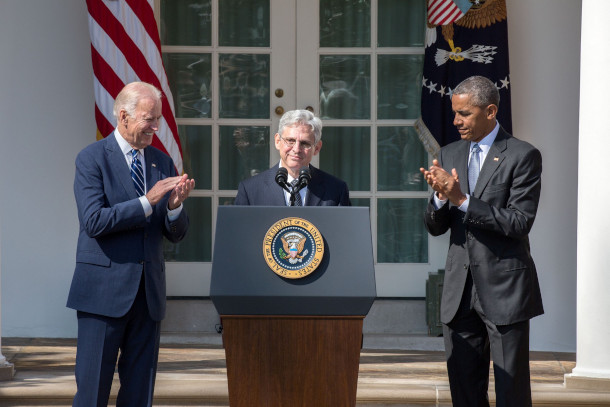
Judge Merrick Garland was nominated by then-President Obama to the Supreme Court in 2016, but his nomination process was delayed and eventually expired at the end of the 114th Congress session. (Photo: Chuck Kennedy, Official White House Photo, Wikimedia CommonsPublic Domain)
BASCOMB: From PRX and the Jennifer and Ted Stanley studios at the University of Massachusetts Boston, this is Living on Earth. I’m Bobby Bascomb.
CURWOOD: And I’m Steve Curwood.
The chief judge of what many call the nation’s second highest court has been tapped by President-elect Biden to serve as attorney general. Merrick Garland has spent more than 20 years on US Court of Appeals for the DC Circuit, which is the exclusive venue to resolve many disputes relating to environmental rules and regulations. In 2016 Senate Republicans blocked Judge Garland’s nomination by President Obama to the US Supreme Court. But when Democrats take charge of the Senate on January 20th Merrick Garland’s confirmation as attorney general seems likely to breeze through. Vermont Law School Professor Pat Parenteau, joins us now for a look at Judge Garland’s record. Hey Pat, welcome back to Living on Earth!
PARENTEAU: Hi, Steve, good to be with you.
CURWOOD: Pat, what's the motivation for Mr. Biden to select Merrick Garland?
PARENTEAU: Well, Garland is a brilliant legal mind, who's known as a centrist or moderate. He's got deep experience, having been at DOJ and of course, most recently as the chief judge of the powerful DC circuit. I think the other thing is Garland is the kind of steady hand that's going to revitalize the Department of Justice. I mean, that place has really been demoralized. In addition to all the bad policy decisions that have been made at the top, that whole staff of lawyers at DOJ, some of whom I know very well, are waiting to be liberated. And I think Garland has the kind of stature and integrity to do that.
CURWOOD: Merrick Garland, the chief judge of that DC Circuit Court of Appeals, to what extent does moving him over to be AG mean that Mr. Biden will be able to appoint a much younger person as chief judge?
PARENTEAU: Yes. And I'm sure that President Biden, who will be President at that point, will take full advantage of that. And that underscores the importance of those two Georgia Senate races, because now the ability to get the appointments to the bench through the Senate is much easier. There's no longer a filibuster, to stop or to require a 60 vote margin to confirm judges. So I'm sure that Biden has another list that's being prepared of replacements for Garland once he goes over to DOJ.
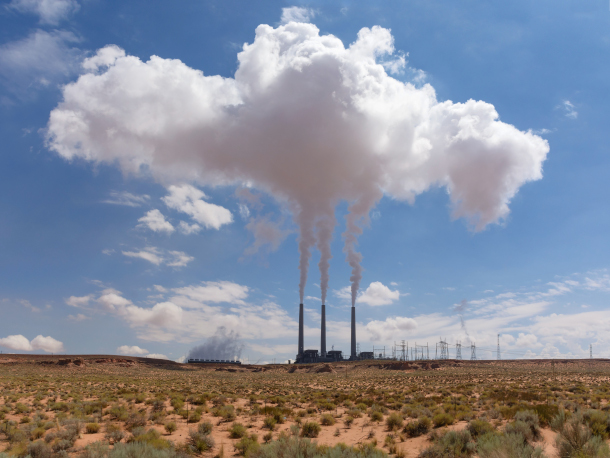
Over the past few years, one of the biggest cases at the US Court of Appeals for the DC Circuit has centered around the Obama Administration’s Clean Power Plan. (Photo: Myrabella, Wikimedia Commons, CC BY-SA 4.0)
CURWOOD: Pat, this isn't typically an environmental issue, but I have to ask you, about Merrick Garland's background as a prosecutor of the Oklahoma City bombers and the domestic terrorism movement and what time and attention he'll now be able to give to that, becoming Attorney General of the United States?
PARENTEAU: Yeah, he's coming at a critical point in our history, that's for sure. And he's got the kind of background to lead the department. And, you know, the thing about Garland is, you're not going to get any spin, or politics. He's a straight shooter when it comes to making independent judgments and being completely transparent. One of the things that marks his demeanor from the Court of Appeals is, he's one of the few judges who's written almost all of his opinions without dissent. He works really hard to convince even more conservative judges of his point of view. And I think when it comes to managing the role of the Department of Justice in dealing with domestic terrorism, which is, unfortunately, on the rise in America right now, you know, it's that kind of steady, predictable, focused on the law, focused on the Constitution, making sure that the government is doing what the government is supposed to do. A lot of the kind of public reassurance that I think we're looking for, Garland is the kind of person to deliver that.
CURWOOD: So, what has been his Environmental record as Chief Justice with the US Court of Appeals for the DC circuit?
PARENTEAU: He's got a strong record on the environment, he's got a deep respect for science. When you read a Garland opinion, reviewing these really technical rules that an EPA adopts under the Clean Air Act, Clean Water Act, and other statutes, you can see right away that he digs into what's the problem in the case, the environmental problem, and how is the law trying to address it? And how did the Agency discharge its responsibilities? He's the kind of judge that if you do your homework, and you've prepared a really good strong record, based on science, he will uphold the Agency. He looks at both the text of these statutes and their purposes. But he's also quick to overturn the Agency when he detects that they have not fully followed the science, haven't listened to their internal experts, for example. He overturned EPA's rule on fine particulates, for example, which is a very dangerous form of air pollution that causes all kinds of respiratory problems. And so in that particular case, he dug into the record, and he found out that the decision makers at EPA did not follow the scientists within the Agency. And he overturned them and send it back and it produced a stronger rule.
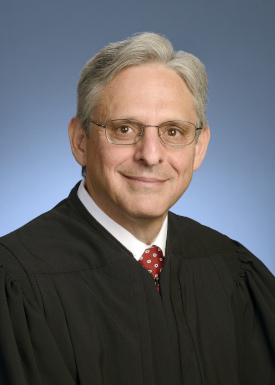
Merrick Garland has served on the US Court of Appeals for the District of Columbia circuit since 1997. He has been the chief judge there since 2013. (Photo: United States Court of Appeals for the District of Columbia Circuit, Public Domain)
CURWOOD: Now, what's going to be some of Judge Garland's responsibilities as Attorney General vis a vis the environment? What will he be astride?
PARENTEAU: He's gonna be riding a bucking bronco, I guess you'd say because he's faced with two dozen, at least, major environmental cases challenging rules of the Trump administration, on you know, clean energy, clean air, clean water, endangered species right down the list. There's a very, very long list. So one of the first things that he's going to have to grapple with is changing the position of the Department of Justice in these cases. That's a delicate dance, because the government under Trump has taken a position in these cases. And now Garland is going to have to review and find a way if it's, you know, permissible for the government to extract itself from that position, take these rules back, redo them, and then defend a new set of rules. I haven't seen that in my career spanning now, four and a half decades, I've never seen a situation where the Department of Justice is going to be faced with having to reverse its position in so many cases, and it's gonna have to be done very delicately. That's one big thing he's facing. Another one; we've seen evidence now that the enforcement of environmental laws across the board has gone down, but in particular, criminal enforcement has all but disappeared. There just simply hasn't been any vigorous enforcement of the criminal offenses of environmental law in the Trump administration, under William Barr, and so forth. So he's gonna have to stand up and deploy the whole, you know, staff of lawyers and inspectors and investigators to recreate the criminal enforcement program
CURWOOD: He certainly has a full plate coming in. And you sound enthusiastic about his nomination for this position.
PARENTEAU: I am enthusiastic, I mean, he is not really aggressive, I would say. As a judge, he was not, you know, as green as someone like J. Skelly Wright or David Bazelon, who preceded him in the DC circuit and wrote some of the seminal environmental decisions in our, our jurisprudence. But what I like about Garland is he's fair, he's open, he can be persuaded, he makes you do your homework. And I can't complain about that. And in fact, I think that probably gives him more credibility than someone who might be perceived as leaning towards the environmental position in every case. I think that probably stands the Department of Justice in good stead. He needs to, you know, tell the troops to follow the law, follow the facts, be honest, be open, and do your job. And so for that reason, I'm very excited to see Garland. He's got the kind of experience to really lead the Department of Justice, and back up the environmental enforcement branch of DOJ, when the inevitable political backlash happens. When DOJ starts to change its position in some of these cases, and take a more aggressive role in enforcing environmental law against major corporations in the country, for example, you know, there's going to be pushback coming. And having somebody who understands that, and who not only is prepared to defend the department, but to make sure that what the department has done is defensible, is incredibly important.
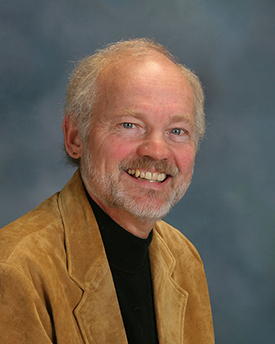
Former EPA Regional Counsel Pat Parenteau teaches environmental law at Vermont Law School (Photo: Courtesy of Vermont Law School)
CURWOOD: Part of President-elect Biden's climate plan is to create an Environmental and Climate Justice Division within the Department of Justice. What do you think we can expect to see from this division? And how might Judge Garland manage this?
PARENTEAU: Yeah, it's going to be interesting to see if he creates what appears to be a special section of DOJ devoted to enforcement of what are called, you know, disproportionate impact on Black, Brown, low-income communities that, of course, have suffered from frankly, institutional racism, even under environmental law. You know, I hate to have to admit that as an environmental law professor, but it's true. You know, the siting of facilities, the lack of enforcement of basic environmental, air and water quality laws in communities, is rampant. Flint, Michigan is just, you know, one of the symptoms of a much deeper problem of the lack of environmental law really protecting these very vulnerable communities. So when he creates this section, it'll be interesting to see who he appoints to be the head of that. One person that I think is going to be in the running is Patrice Simms, who's with the Earthjustice organization and has been on the transition team for EPA. A very, very well respected Black attorney with with a great record of accomplishment, and a keen understanding of what this kind of office could do, including things like bringing, you know, class actions on behalf of large segments of communities that have been suffering from these disproportionate impacts and not, you know, favoring big industries, simply because they have such political and economic clout, not being afraid to take on, you know, the biggest polluters out there, instead of giving them immunity, which is what the Trump administration did during the COVID crisis. I can see Garlad and this new unit, becoming kind of a leading edge of enforcement and prioritizing enforcement actions. You can, having been at EPA myself, I know that you can, you know, you can dilute your effectiveness by trying to enforce too many of the smaller violations. The real impact of environmental enforcement is when you can bring to bear the maximum ability of the federal government to correct really serious environmental problems where people are dying from exposure to air and water pollution. And I think we can begin to see that kind of focus and concentration coming out of a Garland-run DOJ.
CURWOOD: Pat Parenteau is a professor of environmental law at Vermont Law School. Pat, thanks so much for taking the time with me today.
PARENTEAU: It was a pleasure, Steve. Thank you.
Related links:
- Grist | “How Merrick Garland Could Figure Into Biden’s Climate Plans As Attorney General”
- The Washington Post | “The Energy 202: What Merrick Garland As Attorney General Means for the Environment”
- More on Pat Parenteau
[MUSIC: Roy Hargrove, “I’m Not So Sure”, on Earfood, Groovin’ High]
BASCOMB: If you enjoy listening to Living on Earth, consider signing up for our newsletter. You’ll have access to show highlights and advanced information about upcoming live virtual events. The newsletter is sent to your inbox weekly. Don’t miss out, subscribe at the Living on Earth website, loe.org That's loe.org. And you can write to us any time at comments@loe.org that’s comments@loe.org.
[MUSIC: Roy Hargrove, “I’m Not So Sure”, on Earfood, Groovin’ High]
BASCOMB: Coming up – Former Secretary of the Interior Sally Jewell on the opportunities and challenges for public lands and Native Americans in the upcoming Biden administration.
ANNOUNCER: Support for Living on Earth comes from Sailors for the Sea and Oceana. Helping boaters race clean, sail green and protect the seas they love. More information at sailors for the sea dot org.
[CUTAWAY MUSIC: John Coltrane Quartet, “All or Nothing at All” on Ballads, by John Coltrane, Impulse!/Universal Records]
Deb Haaland: ‘Fierce for our Planet’
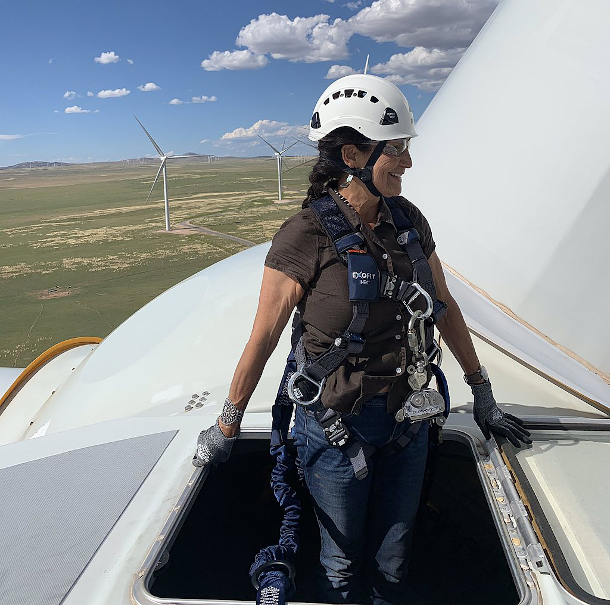
Deb Haaland on top of a wind turbine at El Cabo Wind Farm in New Mexico, August 2019. (Photo: Office of Congresswoman Deb Haaland, Wikimedia Commons CC BY-SA 4.0)
BASCOMB: It’s Living on Earth, I’m Bobby Bascomb.
CURWOOD: And I’m Steve Curwood
President- elect Biden recently nominated Deb Haaland to be the next Secretary of the Interior. Congresswoman Haaland represents New Mexico’s 1st Congressional district and if confirmed she would be the first Native American to run the Department, which oversees the Bureaus of Indian Affairs and Indian Education as well as wildlife protections and public lands that cover roughly a fifth of the nation. Living on Earth’s Jenni Doering has more.
DOERING: As a member of the Laguna Pueblo tribe, Democratic Congresswoman Deb Haaland often says she’s proud to trace her ancestry back 35 generations on the land that’s much more recently become the state she represents.
HAALAND: The Pueblo Indians migrated to this area of New Mexico in the late 1200s, from Bears Ears, from Chaco Canyon, from Mesa Verde; from various other places out west here.
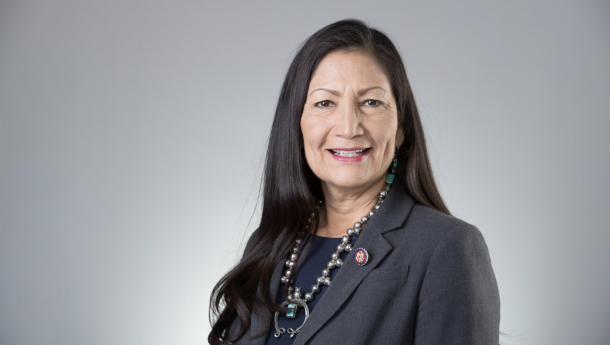
Congresswoman Deb Haaland (D-NM) would be the first Native American Secretary of the Interior if confirmed. (Photo: Office of Congresswoman Deb Haaland, Wikimedia Commons CC BY-SA 4.0)
DOERING: Haaland moved around the country a lot as a kid, with parents who served in the Navy and the Marine Corps, before returning to her family’s ancestral homeland in her teens. Her political career began somewhat late in life but is grounded in her years of organizing native peoples.
HAALAND: My entry into politics really came as an adult because I just wanted more Native Americans to vote.
DOERING: That volunteering involved a lot of hard work canvassing and making phone calls, and even hearty New Mexican cuisine.
HAALAND: When I was organizing in Indian Country, I cooked a lot of food, that’s something that you can get people to come out for. And so I realize it’s different in so many communities but I loved being in Indian Country, because I know what it’s like to be Native, and I know what it’s like to converse with folks in those communities. So there you go, the big pots of green chile stew sometimes went a long way with the work I was doing and getting volunteers to show up for me.
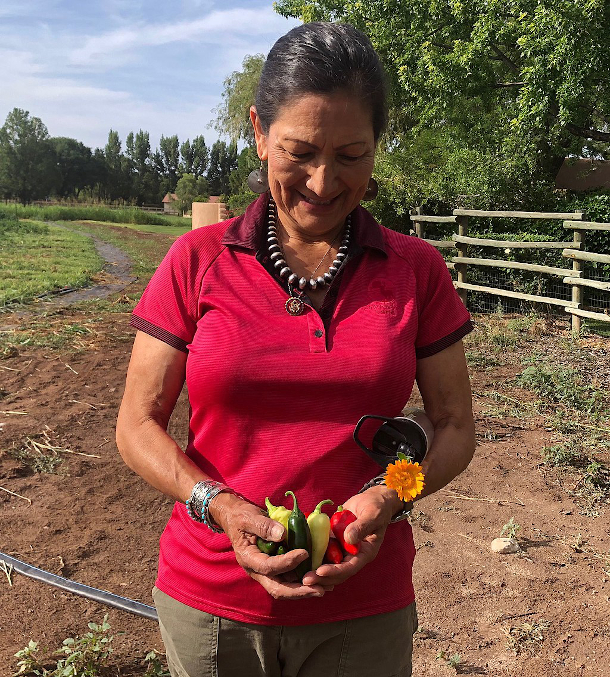
Deb Haaland sampled peppers at a New Mexico farm in August 2019 as part of a tour that helped inform a Farmer’s Bill of Rights she introduced in February 2020. (Photo: Office of Congresswoman Deb Haaland, Wikimedia Commons CC BY-SA 4.0)
DOERING: Chiles also helped put food on the table. While Haaland worked her way through law school as a single mom, she started a salsa company called Pueblo Salsa for some extra income.
HAALAND: You know, I lived paycheck to paycheck just like everybody else and I never even had a savings account. I know what it’s like to be on food stamps, know what it’s like to piece together health care for me and my child. And so I feel like in this day and time, in the middle of a pandemic with economic struggles and environmental injustice we need folks who are “close to the pain”, as my dear friend Ayanna Pressley says. And so I count myself as sort of, an everyday person who worked really hard, and ran for Congress and won.
DOERING: She’s also run several marathons, and sees political campaigning as a similar test, with lots and lots of training, then powering out the first 20 miles, and fighting hard through the grueling final six. After an unsuccessful 2014 bid for Lieutenant Governor, Haaland chaired the Democratic Party of New Mexico and led Democrats to victory in the state. Then in her 2018 and 2020 Congressional campaigns she ran on a progressive platform of environmental protection, clean energy, Medicare for All and “Abolish ICE”, U.S. Immigration and Customs Enforcement. Deb Haaland faced strong competition in her 2018 primary but easily won her seat in the general election as part of a Democratic sweep in her state and the nation. In her first term, she cosponsored the Green New Deal and made Native American issues a focus, sponsoring bills on everything from tribal broadband access, to nutrition, to COVID-19 relief for tribes. As a member of the House Committee on Natural Resources, at a 2019 hearing she questioned David Bernhardt, the man she could succeed as Secretary of Interior.
Why I #RunWithTheMarines ???????? pic.twitter.com/G2tgH6X8nj
— Rep. Deb Haaland (@RepDebHaaland) October 27, 2019
[GAVEL SOUND]
GRIJALVA: Thank you. The committee will come to order…
HAALAND: I’m going to read you a definition of tribal consultation, and that is, “to ensure tribes have a strong voice in shaping federal policies that directly impact their ability to govern themselves.” Do you agree with this definition?
BERNHARDT: Um, I agree that that’s potentially a definition.
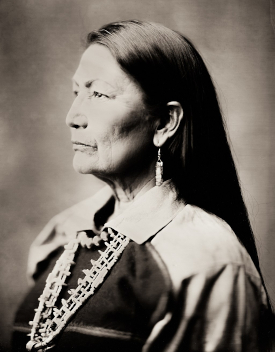
Congresswoman Deb Haaland, Laguna Pueblo (D-NM), captured in the historic wet plate collodion process of pure silver on glass for “Northern Plains Native Americans: A Modern Wet Plate Perspective”. Archived at the North Dakota Historical Society in Bismarck. (Photo: Shane Balkowitsch, Wikimedia Commons CC BY-SA 4.0)
HAALAND: Uh, well, I hope you agree with it because that is your Department’s definition. I can confidently tell you that no tribal leader that I’ve talked to understands what the agency is doing, so perhaps it’s a matter of communication that needs to be addressed.
DOERING: Congresswoman Haaland also sponsored a “30 by 30” resolution to conserve thirty percent of America’s lands and waters by 2030, something President-elect Biden has said he supports. And she cosponsored a bill that would protect Chaco Canyon, a sacred ancestral homeland to the Pueblo people, from nearby oil and gas development. At the 2020 Democratic National Convention, Representative Haaland addressed a virtual audience, hoping to motivate Democratic voters to the polls.
HAALAND: I stand here today, a proud 35th generation New Mexican and one of the first Native American women ever elected to Congress. I’m a symbol of our resilience, as the embodiment of America’s progress as a nation.
DOERING: In 2018, just after her historic election to Congress, Representative Haaland spoke with Living on Earth about where her resilience comes from.
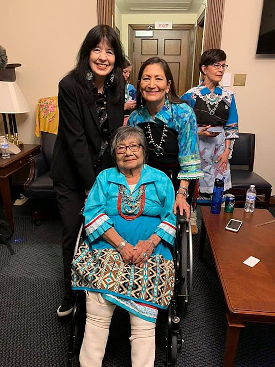
Deb Haaland credits her resilience to the strong women in her family. Above, Congresswoman Haaland and her mother (seated) are joined by Joy Harjo, the first Native American U.S. Poet Laureate. (Photo: Office of Congresswoman Deb Haaland, Wikimedia Commons CC BY-SA 4.0)
HAALAND: You know, when I think about my grandmother, who, her and my grandfather, they moved to Winslow, Arizona to work on the railroad – that was part of the assimilation policies of our U.S. government back in the early 1900s, so they moved probably in the late teens. My grandmother used to clean diesel train engines, with a bucket of kerosene and a brush; she worked the midnight shift. She kept the trains in Winslow, Arizona running on time. So I just feel like I come from this long line of very strong women – my grandmother, my great-grandmother, my mom, who is a Navy veteran and still lives out at Laguna today; so I hopefully will make my mother and my grandmother proud.
DOERING: And when Congresswoman Haaland gave a speech accepting her nomination as Secretary of the Interior she again thought of her mother.
HAALAND: Growing up in my mother’s Pueblo household made me fierce. I’ll be fierce for all of us, for our planet and all of our protected land, and I’m honored and ready to serve.
DOERING: With all the challenges now facing public lands, from climate change to fossil fuel extraction, if she’s confirmed Deb Haaland will have an ultra-marathon of work ahead of her, but she’s been training for it all her life. For Living on Earth, I’m Jenni Doering.
Related links:
- Listen to LOE’s 2018 interview with Deb Haaland
- Watch Congresswoman Deb Haaland’s conversation with Professor Linda Bilmes of the Harvard Kennedy School
- Find out more about the legislation Congresswoman Haaland has sponsored and cosponsored
- About Congresswoman Deb Haaland
[MUSIC: Paula Fuga, “Nose Flute Dub” on Lilikoi, by Paula Fuga, Punahele Productions]
Interior’s Next Frontiers
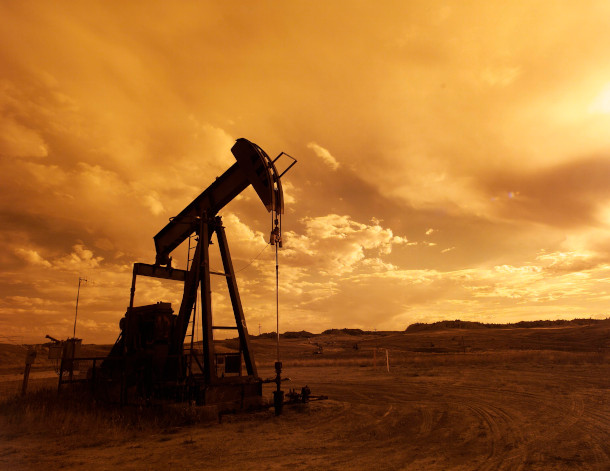
An oil pumpjack stands near Casper, Wyoming. President-elect Biden has pledged to stop issuing new leases for oil and gas drilling on public lands during his time in office. (Photo: US Department of Energy, Flickr, Public Domain)
BASCOMB: Assuming she is confirmed, Deb Haaland has her work cut out for her. She’ll be the top boss for more than 400 sites and 85 million acres in the National Park system. She’ll also be in charge of the Fish and Wildlife Service, which oversees endangered species protections and manages roughly 150 million acres in the National Wildlife refuge system. And she’ll have final say at the Interior Department about the quarter of a billion acres of other public lands handled by the Bureau of Land Management, and whether or not those lands, along with offshore areas, be mined for coal, gas, and oil. Deb Haaland also would be the first Native American to direct Interior which manages federal relations with more than 570 Native American tribes. And following the lead of President-Elect Biden, she’s expected to move to reverse President Trump’s extraction-friendly and climate-oblivious agenda. Sally Jewell served as Secretary of the Department of Interior under President Obama, and joins us now with some insights into what her old job could be like for Deb Haaland. Welcome back to Living on Earth, Secretary Jewell!
JEWELL: Thank you. It's great to be here, Bobby.
BASCOMB: President-elect Biden has pledged to grant no new oil and gas leases on federal lands and waters. How realistic is it to expect that the Department of Interior, would it be able to follow through on that pledge?
JEWELL: Well, the reality is that the program for oil and gas leasing, just as it was for coal leasing, has not been reviewed in many decades. And it is important that it be reviewed, and I would absolutely launch what's called a programmatic environmental impact statement on the federal leasing of lands and waters for oil, gas and mineral extraction. You know, would that undermine, you'd immediately have a human cry saying, "Well, wait a minute, you know, there's a lot of jobs at stake," and so on. There are many jobs, certainly, in the oil and gas sector. But there's also over 10,000 permits to drill that are issued already that haven't been drilled. There is a pent-up supply of existing leases that can be developed, as long as, you know, they make sense to develop and they, they follow regulatory guidelines. So it makes all the sense in the world to say, let's put a pause on it. You got plenty in your pipeline already, pardon the pun. We have to do things as a public servant that are in the public's interests, not in supporting special interests. And that's what needs to happen. And I think it should happen relatively quickly.
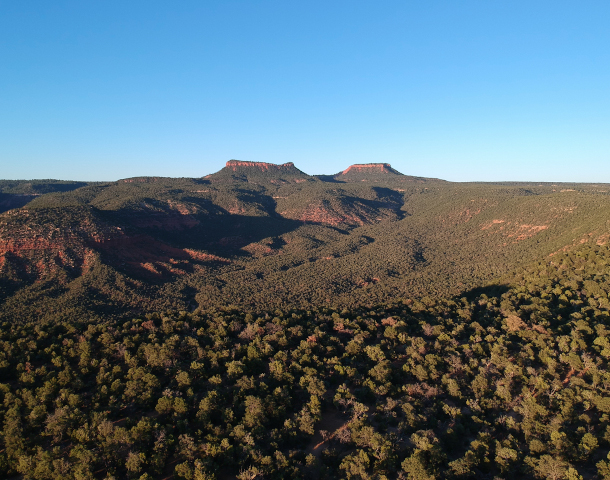
Bears Ears is an area in southeastern Utah, sacred to many Native American tribes. The Bears Ears National Monument was created by President Obama and extensively reduced in size by President Trump (Photo: Bruce Rinehart, Wikimedia Commons, CC BY-SA 4.0)
BASCOMB: What are some of the other ways that the Department of Interior might be able to curb greenhouse gas emissions and even help us transition to more renewable energy?
JEWELL: Well, the Department of the Interior has a major role. And one of the things that I noted early on in my time as Secretary of the Interior was that in my first six weeks on the job traveling around the lands and waters that were under the jurisdiction of the Department of the Interior, that climate change was everywhere I looked. On the landscapes and in the waters, you could not deny that it was going on, it's very obvious. The Department of the Interior and the 20% of U.S. lands that are under its jurisdiction, in addition to the additional 10% that is under USDA and the Forest Service, are massive forests and reservoirs for carbon sequestration. They are wetlands and dunes and mangroves and wildlife refuges that protect inland communities from coastal flooding, and sea level rise. They are national parks and protected lands and wildlife corridors that are absolutely critical to biodiversity, especially at this time of climate change. So Interior's role is multifaceted. But the Department of Interior also plays a major role in mitigating climate change by finding alternative sources of energy to fossil fuels, and reducing the consumption of fossil fuels in our country. So, great example, during the time that the Obama administration was in charge, we had a massive effort in the whole Mojave Desert and Sonoran Desert in California around land use planning to drive renewable energy in the right ways and in the right places. So we did all the scientific research around endangered species like the desert tortoise, around the bird migration corridors and wind energy, around the prospective migration corridors for bighorn sheep, which were endemic to that area, around areas that needed to be protected as Joshua trees, for example, move upslope. And we said to industry, if you develop in these areas that have been set aside for utility-scale, renewable energy, we will expedite your permitting. That's thoughtful regulation that drives renewable energy development to the right places, that are close to transmission, already in disturbed areas, have been pre-cleared with the environmental impact statements already done, so that they can get that solar farm or wind farm up and operational much quicker and a much lower cost. So those are some of the things that interior can and is doing that are really, really important in addressing climate change, and looking to shift from our dependence on fossil fuels to non-carbon emitting sources of energy that are really critical for our economy.
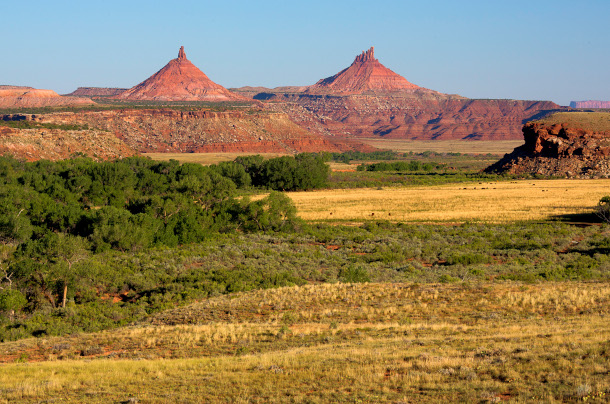
Two sandstone summits, called the Sixshooter Peaks, rise above the horizon of the Bears Ears National Monument. (Photo: Bureau of Land Management, Wikimedia Commons, Public Domain)
BASCOMB: Now, if Deb Haaland is confirmed, she will be the first Native American in charge of the Department of Interior, which of course oversees the Bureau of Indian Affairs. What do you see as the challenges and opportunities for the Department of Interior when it comes to working with native peoples?
JEWELL: During my time as Secretary of the Interior, one of the most rewarding parts of the job was getting to know the indigenous communities within the United States. I came to deeply respect and appreciate the relationship of these indigenous peoples to the land, and their deep understanding of a landscape in balance. You know, there's a concept of wilderness being "untrammeled by man," which is mythology. It has been trammeled by man, and lived in harmony by man, since time immemorial, including in, in the United States, at least for parts of the country since the Ice Age, you know, tens of thousands of years ago. So I hope that the Department of the Interior rebuilds that respectful relationship. And if Congresswoman Haaland is confirmed as Secretary, I know that will be a priority of hers. Bring back the Tribal Nations Conference and invite tribal leaders back to Washington D.C. Reinstate the White House Council on Native American Affairs and bring all of those agencies together, because yes, Interior is involved and is viewed as an advocate. But every single agency of the federal government must do its part to uphold trust and treaty obligations to our nation's first people. And we have not done a good job.
BASCOMB: Now, Secretary Jewell, you were closely involved in working with tribes and other stakeholders to get the Utah Bears Ears National Monument designation across the finish line during the Obama administration. Then the Trump administration came along and cut the size of that monument by roughly 85%, basically to allow for fossil fuel extraction. What can a Biden Interior Department do to try to restore that?
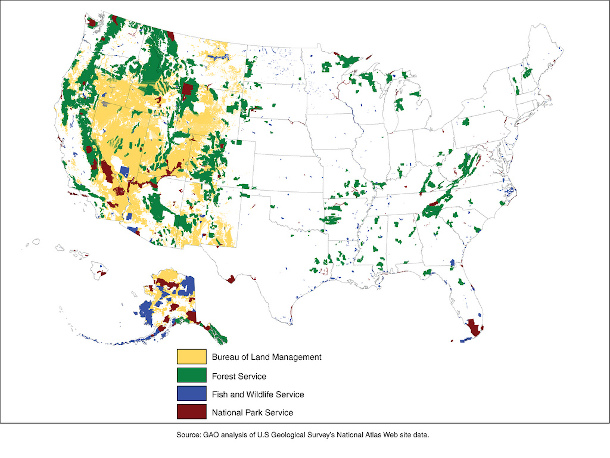
A map of all federally owned lands in the United States. (Photo: U.S. Government Accountability Office, Flickr, Public Domain)
JEWELL: Well, first, the rescinding or shrinking of Bears Ears National Monument has been challenged in the courts, and has been making good progress. I hope and expect that the Biden administration will reinstate Bears Ears National Monument, and Grand Staircase-Escalante National Monument. The one thing that is unique about Bears Ears, and there couldn't have been a place that's more tailor-made for the Antiquities Act, than Bears Ears, is that it is sacred to five different tribes that advocated for it. There are over 100,000 cultural sites, and I've been to many of them. They teach us stories about these people and how they lived. As I went deep into the monument after leaving Interior with a guide, I saw a sandal made 1200 years ago, that was tightly woven, intricately woven. And I saw another sandal that was 400 years newer, that was a coarser weave. And what do we learn from that? The Basketmaker period, to the period of pottery. Those early baskets needed to carry water. The later weaving was to protect the bottom of your foot, but it didn't need to carry water, right? So they had lost that technique in that intervening years, even though that coarsely woven sandal was newer. These are lessons you learn from a place like Bears Ears, and of course, why are the sandals there? Most likely erosion around burial sites. There are cliff dwellings all over the place. And they were being looted. And many of those artifacts, like the sandals that I described, will not be there. Because people will go up and take a picture with their iPhone, and they'll post it on their Instagram. And they'll think, gosh, isn't this cool? And somebody else will see exactly where that is. They've just given them instructions with the geo tagging. So the threat was there. The Trump administration undermined it for no good reason, it absolutely needs to be reinstated. But I also think the Antiquities Act could be clarified so this never happens again.
BASCOMB: The events of January 6, have made it very clear just how very divided we are as a country right now, I think a lot of us were shocked to see those images. But one of our greatest treasures, I think, are the public lands that we've been talking about here, that belong to all of us. To what extent do you see places like that, our national parks and monuments, as spaces, you know, that can ideally bring Americans together in some way?
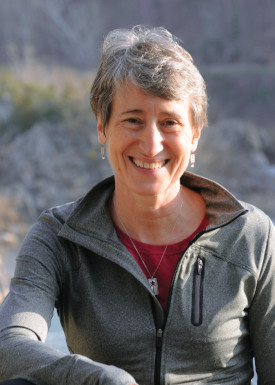
Sally Jewell, former US Secretary of the Interior under President Obama. (Photo: Wikimedia Commons, Public Domain)
JEWELL: Our public lands have become more obviously important to more people during this global pandemic of Covid-19 than they were before. They have always been America's public lands, not Republican national parks and public lands, or Democratic, but America's public lands. And I think that's really important. I will say that, how we use our public lands and who owns them and what that means is not universally understood in the same way across the country. Some of the people who are now being charged with the riots and the insurrection on Capitol Hill on January 6, are some of the same groups that we dealt with in trying to uphold the laws, for example, in Bunkerville, Nevada, with the Bundy family, who had not paid grazing fees for over 20 years and was in arrears to the federal government. There was a Sagebrush Rebellion some years back; I had to deal with the occupation of the Malheur National Wildlife Refuge by members of the Bundy family, but a number of the people associated with some of the groups that have been named in the recent attacks on the Capitol. Some people view it as their birthright to use public lands for their own private purposes. And one of the great blessings that we have as Americans is that the best places around our country were not set aside for kings and queens and nobility, as they are in so many other parts of the world. The best places were set aside for all of us, through our public lands, and, of course, the crown jewel of those being our national parks. And I hope that as we look to the future, we recognize that value and we care for these places. And in making difficult decisions, as Secretary of the Interior, there is a proverb that I have always used to think about the decisions that I had to make, and that is that we don't inherit the earth from our ancestors, we borrow it from our children. And when you think about that, and you think about the difficult decisions that you have to make, it gives you a different lens that says, this is not just for today, these decisions are going to impact generations yet to be born. And am I thinking about that, in all of the work that I do every single day in stewarding these resources forever.
BASCOMB: Sally Jewell served as Secretary of the Interior under President Obama. Secretary Jewell, thank you so much for taking this time with me today.
JEWELL: Thank you for having me, Bobby, and I appreciate the great work of Living on Earth.
Related links:
- The Nature Conservancy | “About Sally Jewell”
- Washington Post | “Biden Vowed To Ban New Drilling on Public Lands. It Won’t Be Easy.”
- Bears Ears Inter-Tribal Coalition | “Bears Ears National Monument: Native American Connections”
[MUSIC: John Scofield, “Just Don’t Want To Be Lonely” on Überjam Deux, Longsolo]
CURWOOD: Just ahead- A Mayan woman in Mexico takes on the agro-chemical industry, and wins.
ANNOUNCER: Funding for Living on Earth comes from you, our listeners, and United Technologies, combining passion for science with engineering to create solutions designed for sustainability in aerospace, building industries, and food refrigeration.
[CUTAWAY MUSIC: Santana (featuring Eric Clapton), “The Calling” on Supernatural, by Carlos Santana, Arista Records]
Beyond the Headlines
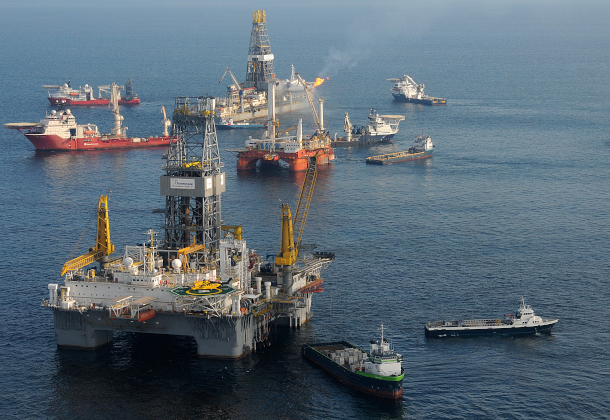
The mobile offshore drilling unit (near) prepares to drill a relief well at the Deepwater Horizon site, as another unit holds position directly over the damaged blowout preventer. Drillship Discover Enterprise (far) captures oil from the ruptured riser. (Photo: Petty Officer 3rd Class Patrick Kelley, U.S. Coast Guard, Flickr, CC BY-ND 2.0)
BASCOMB: It’s Living on Earth, I’m Bobby Bascomb.
CURWOOD: And I’m Steve Curwood.
Let's take a look beyond the headlines now with Peter Dykstra. Peter's an editor with Environmental Health News. That's EHN.org and DailyClimate.org. He's joining us now on the line from Atlanta, Georgia, where you've been looking out beyond those headlines, Peter and seeing what?
DYKSTRA: Hi, Steve. Well, last year is not everybody's favorite year 2020. But in one category, we were number one, or at least tied for number one, because 2020 and 2016 are tied as the hottest year ever on record.
CURWOOD: Yeah, I'm not sure that that's a record that 2020 should be proud of, or actually anybody on the planet. So what are we talking about?
DYKSTRA: The global average temperature in 2020, was about two and a quarter degrees Fahrenheit warmer than the average, or the global average temperatures from the year 1850 to 1900. That data comes from the Copernicus Climate Change Service. They're one of the number keepers for how hot it is.
CURWOOD: Now, Peter, I think all of these hot years have been in fairly recent decades, right?
(Video: Global Warming from 1880 to 2019, NASA, Public Domain)
DYKSTRA: 1998 was the most distant year to make the top 10. Every year other than that has been in the 21st century, which is barely one fifth old.
CURWOOD: Yeah. And it keeps going up and up and up. Makes me think we're in a runaway reaction, Peter.
DYKSTRA: I think we are.
CURWOOD: Let's turn now, though, to other news, what do you have for us?
DYKSTRA: Well, we have something that may be one of the causes of that runaway climate reaction. There was a survey of the Gulf of Mexico, there are 10s of 1000s of abandoned oil and gas wells. The fact that there are regulations not enforced leaves climate warming gas emissions unchecked, specifically, methane.
CURWOOD: And how big a deal is the amount of methane being released do you think?
(Video: Methane Sources, NASA, Public Domain)
DYKSTRA: Well, according to NASA, methane is 28 times as potent a greenhouse gas as CO2. A lot of other agencies say methane is even worse than that. But NASA also says that during the entire 20th century, methane is responsible for 23% of all climate change.
CURWOOD: So just how many of these wells are around perhaps leaking methane, do you think?
DYKSTRA: 10s of 1000s in the Gulf of Mexico alone, of course, there's offshore drilling off of West Africa and Russia, in the Mexican part of the Gulf of Mexico, and so many other locations around the globe, that what happens in the Gulf is only part of what happens around the world. And a lot of that is due to not poor enforcement of laws, but the fact that there are nearly no enforcers out there looking for leaky wells.
CURWOOD: Let's take a look back at history Peter and tell me what you see.
DYKSTRA: We have a birthday! Aldo Leopold, one of the greatest, most influential environmental authors had a birthday on January 11, the year 1887. His most famous book is A Sand County Almanac.
CURWOOD: Well tell me what's in the book.
DYKSTRA: Well, Sand County is a mythical version of his home, which was Sauk County, Wisconsin, in the town of Baraboo, Wisconsin. The book was just a wonderfully written inventory, if you will, of wildlife and nature near his home. Another irony about the mythical Sand County is it's in the region of southwestern Wisconsin that was heavily mined for fracking sand in the last couple of decades, even that's begun to decline as the fracking industry falls into disfavor.
CURWOOD: Baraboo has another claim to fame, right?
DYKSTRA: Oh, yeah. It's home of the International clown Hall of Fame!
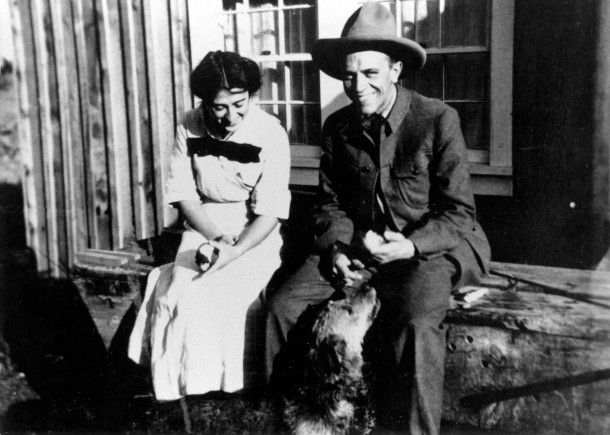
Author and ecologist Aldo Leopold (right), with his daughter, Estella (left). (Photo: Pacific Southwest Forest Service, Flickr, CC BY 2.0)
CURWOOD: I wasn't thinking of that. Peter. I was thinking of the International Crane Foundation.
DYKSTRA: Well, it is the home of the International Clown Hall of Fame although Aldo Leopold is not a member. The International Crane Foundation are environmental heroes, for among other things, they're considered the saviors of the Whooping Crane. Aldo Leopold, by the way, died in 1948, while helping a neighbor battle a fire. A Sand County Almanac, his most famous book, wasn't even published till a year after his death.
CURWOOD: Thank god they found the manuscript Peter. Peter Dykstra is an editor with Environmental Health News. That's EHN.org and DailyClimate.org. We'll talk to you again real soon, Peter.
DYKSTRA: All right, Steve, thanks a lot. Talk to you soon.
CURWOOD: Thank you. And there's more on these stories at the Living on Earth website. LOE.org.
Related links:
- The NY Times | “2020 Ties 2016 as Hottest Yet, European Analysis Shows”
- NASA | Methane Sources Video
- Environmental Health News | “Unplugged: Abandoned Oil and Gas Wells Leave the Ocean Floor Spewing Methane”
- The Aldo Leopold Foundation | A Sand County Almanac
[MUSIC: Jacky Terrasson, “The Call” on 53, Decca Records France]
A Mayan Bee Guardian
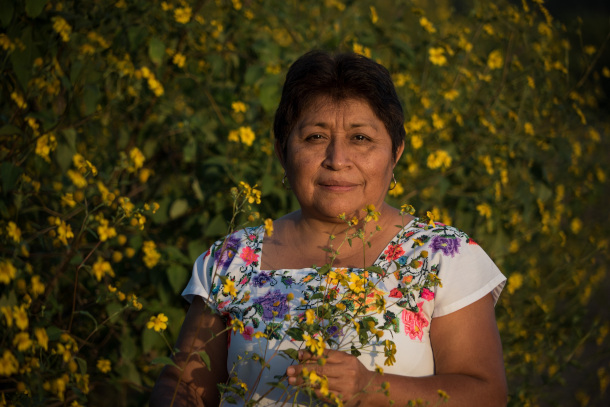
Leydy Pech is a Mayan beekeeper known as “la guardiana de las abejas” or “the guardian of bees”. In this picture, Leydy is holding a flower called “tajonal”, which is a source of nectar for the bees in Yucatan and the surrounding region. (Photo: Courtesy of the Goldman Environmental Prize)
BASCOMB: For the Mayan communities of Northeastern Mexico beekeeping is a sacred practice that goes back more than 3,000 years. And the forests of the Yucatan peninsula, full of flowering plants, are an ideal location for raising bees and producing honey. But starting in 2012 farmers in the region began growing soybeans that had been genetically modified so they could be sprayed with the herbicide glyphosate without damaging the crop. But, glyphosate is considered a probable carcinogen by the World Health Organization and bee keepers in the region soon had a problem. Leydy Pech, a Mayan woman and beekeeper, noticed her bees were disoriented and dying on a large scale. So, Leydy began organizing her community to push back against the use of glyphosate on their land. Her efforts went all the way to the Mexican Supreme Court which ruled five years ago that indigenous people must be consulted before GMO soy and glyphosate can be used on their lands. For her work, Leydy won the 2020 Goldman Prize for North America. I started by asking her about what got her started with beekeeping.
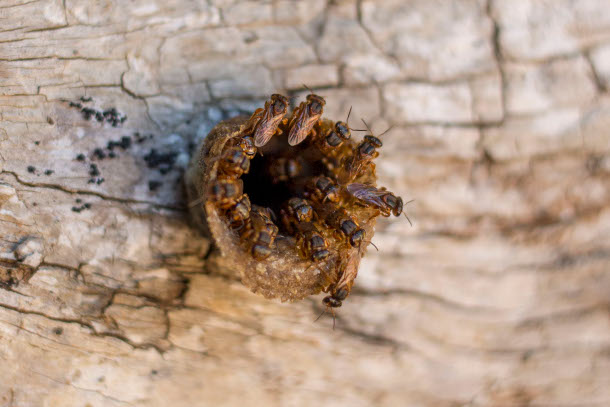
Leydy Pech’s Mayan collective works with a bee called Melipona beecheii, a stingless bee endemic to Central America. (Photo: Courtesy of the Goldman Environmental Prize)
PECH: Well, my relationship with bees has been ancestral. My grandparents kept bees and they mostly took care of a bee called melipona beechei. But the bee hives were kept in the forest, a more natural way of beekeeping. In my municipality, most families are beekeepers, and a large part of the honey production is exported to Europe. So beekeeping is a patrimony for indigenous community and honey provides an essential income for my family.
BASCOMB: And about a decade ago, farmers started growing genetically modified soybeans and seven Mexican States along the Yucatan Peninsula. How did those crops affect you and your bees?
PECH: When the soy harvest began in our region, there were serious effects on our land and bees there was more deforestation, which led to a loss of animals in medicinal plants. There was water contamination and health problems from permanent exposure to pesticides. When agricultural permits were given for GMO soy production, there weren't adequate environmental studies conducted and our dependence on the forest for sustenance has not been taken into consideration.
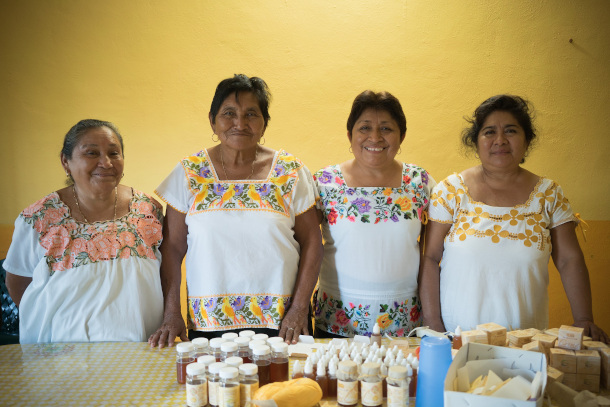
2020 Environmental Goldman Prize winner, Leydy Pech (second from right), next to “las damas de la miel” (the women of honey), who are defenders of the Melipona beecheii. Leydy is a member of the Koolel-Kab/Muuchkambal, an organic agroforestry cooperative where Mayan women lead the way. (Photo: Courtesy of the Goldman Environmental Prize)
BASCOMB: And what kind of changes if any, did you notice in your bees when they started farming with genetically modified soybeans in your region? And how did it affect the honey for that matter?
PECH: Well the first things I began to observe, where the death of bees at a massive rate. Why? Because contrary to what we were being told, bees do pollinate soy. Glyphosate, a herbicide used to control pests is applied to soy fields at a massive rate. Glyphosate has been categorized as a possible carcinogen by the World Health Organization, and glyphosate is still being applied to crops on our land. There are also other dangerous pesticides which affect our bees, such as neonicotinoids neonicotinoids are extremely dangerous for bees. They change the behavior of my bees. As my bees began to leave their hives in search of nectar. They became disoriented, got lost and stopped coming back. Also the bee started producing less honey because of deforestation for soy. Bees depend on the plants in the forest to produce honey. So less forest means less honey, which means less money for families who keep bees. The killing of our bee has led to more poverty in our communities.
BASCOMB: Now, what did you do when you realize that these genetically modified soybeans were such a problem for you and your community? How did you approach this problem?
PECH: Well, my reaction was to begin to organize already to invite women and leaders from surrounding communities. multiple organizations around the mining community showed solidarity and began to help us with legal support. We were able to conduct studies and prove that our water has glyphosate residue in the urine of children and field workers who were close to the soil crops was tested in glyphosate residue was found.
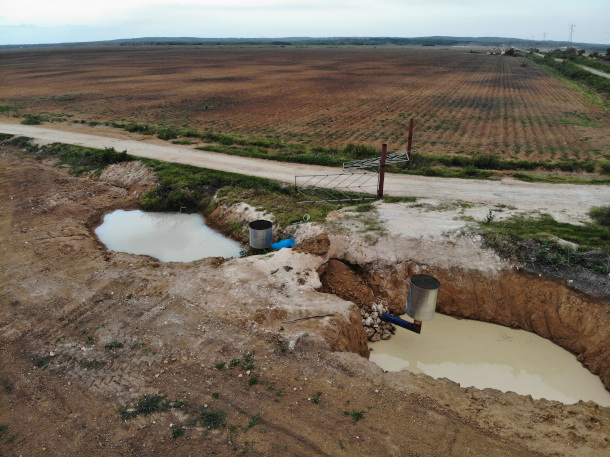
Deforestation in Hopelchén, Mexico has led to a decline in bees, and glyphosate used for GMO soy production has contaminated water supply in the region. (Photo: Courtesy of the Goldman Environmental Prize)
BASCOMB: And so you took this fight all the way to the Mexican Supreme Court, which unanimously ruled in your favor that the government must consult indigenous communities before they plant GM soybeans. How has that worked out though? Have they actually respected that ruling? And how have things changed for your community and the bees?
PECH: Well the protection granted was by the Supreme Court in 2015, prohibits the cultivation of genetically modified soy beans, a rule that the government must consult with indigenous peoples of compassion Yucatan. Unfortunately, that ruling was not respected by Mexican authorities. Today, transgenic soy is still being cultivated in our land. In 2018. As a collective mining community, we decided to wait for the incoming government and appeal to them to respect our rights. The new government promised that they would respect the consultation process, but that didn't happen. Unfortunately, the situation remains the same with the current government. Today we keep fighting for recognition and respect of our sovereignty as an indigenous community.
BASCOMB: So it sounds like there's still a lot of work to be done. What's next for you, Leydy? Now that you've won the Goldman prize? What are your future plans?
PECH: I think that the golden price highlights our determination to continue this fight. I think that struggles like these are long and generational. And it's our responsibility to involve our children and our grandchildren in our fight for justice. Because at the end, having learned to call your own is having a sense of belonging, seeking. So what follows with a price is to continue the word water and essentially, solve it this way. This award reaffirms my conviction to defender my territory.
BASCOMB: Leydy Pech is a defender of Mayan territory and the 2020 Goldman Prize winner for Central and South America. We reached out to SENASICA Mexico's agency responsible for enforcing the Supreme Court's ruling but we did not receive a response in time for broadcast.
Correction: Leydy Pech is the Goldman Environmental size Winner for North America.
Related links:
- Learn more about Leydy Pech and the Goldman Prize
- Mexico News Daily | “Mayan Activist Beekeeper Wins International Environmental Prize”
- National Geographic | “An Unlikely Feud Between Beekeepers and Mennonites Simmers in Mexico”
[MUSIC: Maná, “Mariposa Traicionera” on Six Pack: Maná – EP, Warner Music Mexico]
Ice Visions
A “classic” version of Hoffner’s Ice Visions, photographs of ice-fishing holes as they re-freeze. (Photo: Courtesy of Erik Hoffner)
CURWOOD: As winter settles in over the northern hemisphere people find creative ways to get outside and enjoy nature. For environmental journalist and photographer Erik Hoffner winter is a time for ice skating, a passion which gave rise to some unusual art.
HOFFNER: The first house I rented after moving to New England two decades ago was on a lake. I love ice skating, and felt lucky when a cold, dry December created a perfect scenario for skating just outside my door.
[ICE SKATING SOUNDS]
Most mornings I’d pull on skates and glide across that lake until my legs were shaky and sore. The hiss and scrape of blades on ice was often the only sound against the deep, cold quiet of the sleeping landscape. The ice that first year was so clear I could watch fish swimming below. In early winter as the ice formed I could even hear its groans, cracks and pings through the floor of my house.
A “climate-changed” version of Hoffner’s Ice Visions. (Photo: Courtesy of Erik Hoffner)
[GROANS & PINGS OF ICE]
Then Ice fishermen drilled perfectly round holes in the lake. And overnight tiny bubbles filtering up from sediments below were caught in thickening water inside the holes while inches of new ice formed. The bubbles stretched as the water refroze, creating streaks that radiated from the center outward much like the lines that radiate out in the iris of an eye. These holes seemed to become the lake’s own eyes, gazing at and reflecting the starry night sky. The formations were all different, like snowflakes. In the morning light, they just could look like stars, cells, or galaxies. Now every year in early winter I strap on my skates in a kind of treasure hunt for the holes and shoot black and white photos of them. Over 20 years I built up a huge collection of these Ice Visions. I don’t know what’s more fun, taking the pictures or pulling on my skates to fly over the frozen water on these quiet winter mornings. Some years, though, it snows early, before the ice reaches a safe thickness, making skating impossible. And the photos I take on this choppy, gray canvas are less captivating than when refrozen holes are framed by that smooth, black ice which resembles deep space. Last winter started cold, and good, safe ice set early, but then the weather warmed for a long stretch well into January and what I saw inside the fishing holes surprised me.
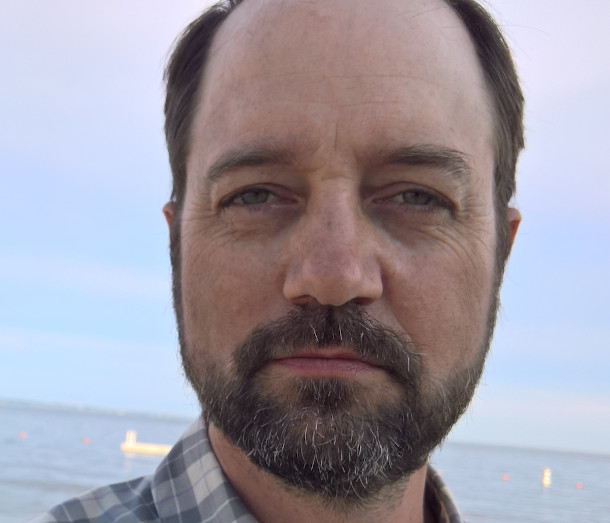
Erik Hoffner is a writer and photographer. (Photo Courtesy of Erik Hoffner)
Instead of building 2 or 3 inches of new ice in each hole overnight, there was often just a skin at the surface, so thin you could poke a finger through it. And the tiny bubbles trapped beneath that thin layer of ice pooled with others to create large, semi-frozen bubbles that oozed and flowed together. They looked entirely different, not so much like eyes or stars but rather distorted faces, and strange animals. It was like seeing the face of climate change. It’s too soon to say whether it will be too warm again this year. But there’s already safe ice on lakes in my town, so I’ve taken the cameras and skates out several times, and look forward to discovering what wonders this winter will bring.
[ICE SKATING SOUNDS]
CURWOOD: Erik Hoffner is a photographer and environmental journalist in Western Massachusetts. His portfolio of photos called Ice Visions is now on display at the Brattleboro Museum and Art Center in Vermont. You can find a link to the exhibit on the Living on Earth website loe.org.
Related links:
- Brattleboro Museum and Art Center | Erik Hoffner: Ice Visions
- Erik Hoffner’s official website
- Erik Hoffner on Instagram
- Watch Ice Visions (2020)
[MUSIC: The Allman Brothers Band, “Dreams” on The Allman Brothers Band (Deluxe), UMG Recordings]
CURWOOD: Living on Earth is produced by the World Media Foundation. Our crew includes Naomi Arenberg, Paloma Beltran, Jenni Doering, Jay Feinstein, Leah Jablo, Mark Seth Lender, Don Lyman, Aynsley O’Neill, Jake Rego, Casey Troost, and Jolanda Omari. We welcome intern Grace Callahan.
BASCOMB: Tom Tiger engineered our show. Alison Lirish Dean composed our themes. You can hear us anytime at L-O-E dot org, Apple Podcasts and Google Podcasts, and like us, please, on our Facebook page - Living on Earth. We tweet from @livingonearth. And find us on Instagram at livingonearthradio. I’m Bobby Bascomb.
CURWOOD: And I’m Steve Curwood. Thanks for listening!
ANNOUNCER: Funding for Living on Earth comes from you, our listeners, and from the University of Massachusetts, Boston, in association with its School for the Environment, developing the next generation of environmental leaders. And from the Grantham Foundation for the protection of the environment, supporting strategic communications and collaboration in solving the world’s most pressing environmental problems.
ANNOUNCER 2: PRX.
Living on Earth wants to hear from you!
Living on Earth
62 Calef Highway, Suite 212
Lee, NH 03861
Telephone: 617-287-4121
E-mail: comments@loe.org
Newsletter [Click here]
Donate to Living on Earth!
Living on Earth is an independent media program and relies entirely on contributions from listeners and institutions supporting public service. Please donate now to preserve an independent environmental voice.
NewsletterLiving on Earth offers a weekly delivery of the show's rundown to your mailbox. Sign up for our newsletter today!
 Sailors For The Sea: Be the change you want to sea.
Sailors For The Sea: Be the change you want to sea.
 The Grantham Foundation for the Protection of the Environment: Committed to protecting and improving the health of the global environment.
The Grantham Foundation for the Protection of the Environment: Committed to protecting and improving the health of the global environment.
 Contribute to Living on Earth and receive, as our gift to you, an archival print of one of Mark Seth Lender's extraordinary wildlife photographs. Follow the link to see Mark's current collection of photographs.
Contribute to Living on Earth and receive, as our gift to you, an archival print of one of Mark Seth Lender's extraordinary wildlife photographs. Follow the link to see Mark's current collection of photographs.
 Buy a signed copy of Mark Seth Lender's book Smeagull the Seagull & support Living on Earth
Buy a signed copy of Mark Seth Lender's book Smeagull the Seagull & support Living on Earth

